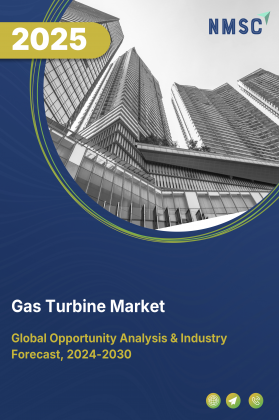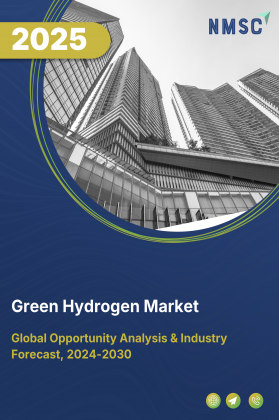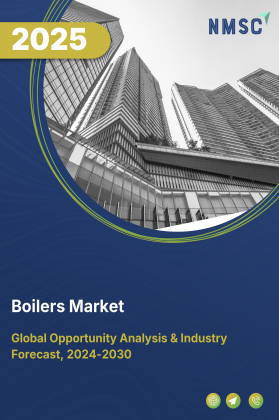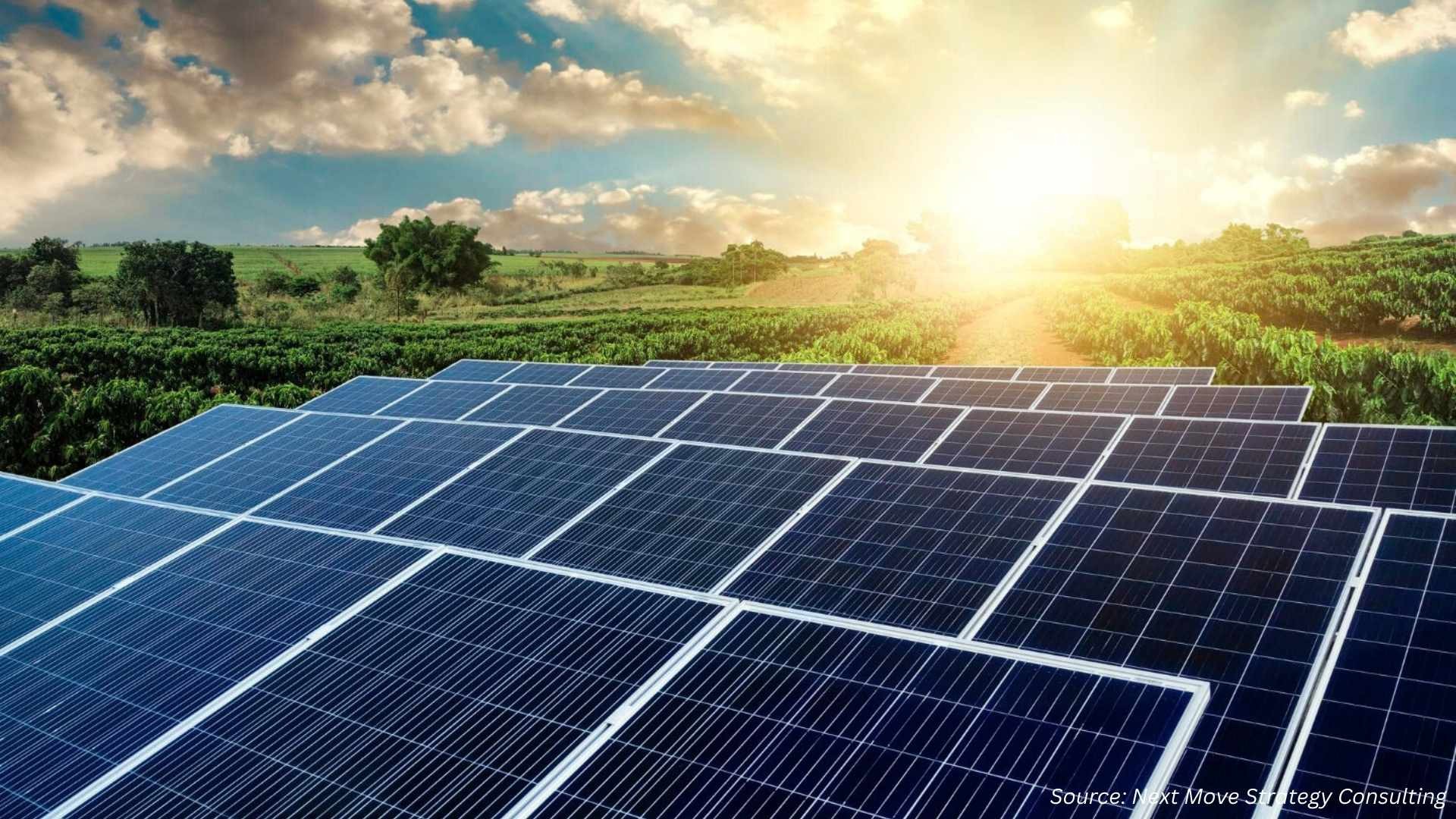
Gas Turbine Market by Type (Heavy Duty Gas Turbines, Aeroderivative Gas Turbines, Industrial Gas Turbines, Micro Gas Turbines, Others), by Fuel Type (Natural Gas, Hydrogen, Diesel or Fuel Oil, Dual Fuel, Biofuels or Synthetic Gas), by Power Output (Below 10 Megawatt, 10 to 50 Megawatt, 51 to 200 Megawatt, Above 200 Megawatt), by Services (Maintenance, Repair, Overhaul, Upgrades, Installation or Commissioning, Others), and Others – Global Opportunity Analysis and Industry Forecast, 2025–2030
Industry Outlook
The global Gas Turbine Market size was valued at USD 44.89 billion in 2024 and is predicted to reach USD 48.84 billion by the end of 2025. The industry is predicted to reach USD 74.46 billion by 2030 with a CAGR of 8.8% from 2025 to 2030. The industry is witnessing robust growth driven by the rising demand for efficient and flexible power generation, especially in combined-cycle power plants that offer high efficiency and rapid load adjustments.
Increasing environmental awareness and stringent regulations are accelerating the shift toward cleaner energy, positioning gas turbines as a low-emission alternative capable of operating on natural gas, hydrogen, and biofuels. Industrial expansion across sectors such as oil & gas, petrochemicals, and marine propulsion further fuels the gas turbine market adoption.
While high capital and maintenance costs remain a challenge, the growing integration of gas turbines with renewable energy sources presents significant opportunities, enabling hybrid systems that enhance grid stability and support the transition to a sustainable energy mix.
Rising Demand for Efficient Power Generation Drives the Market Growth
The global demand for electricity continues to grow rapidly due to population growth, urbanization, and industrialization. Traditional coal- and oil-based power plants struggle to meet this demand efficiently and sustainably. Gas turbines provide a highly efficient solution for power generation, especially when used in combined-cycle power plants, where they achieve efficiencies exceeding 60%.
Their ability to start quickly and adjust output in response to fluctuating electricity demand makes them ideal for modern power grids that require flexibility and reliability. This increasing need for high-efficiency and responsive power generation is driving the adoption of gas turbines across both developed and emerging markets.
Shift Toward Cleaner Energy Sources Boost the Market Demand
With increasing global awareness of climate change and stricter environmental regulations, there is a strong push toward low-emission and sustainable energy solutions. Gas turbines produce significantly lower levels of greenhouse gases, particulates, and other pollutants compared to traditional coal- or oil-fired power plants.
Their ability to run on natural gas, which is a cleaner fossil fuel, as well as hydrogen or biofuels in advanced designs, makes them a preferred choice for reducing the carbon footprint of power generation. Governments and industries seeking to meet emission reduction targets and improve air quality are increasingly investing in gas turbine technology, thereby driving the gas turbine market growth.
Growth in Industrial Applications Fuels Market Expansion
Gas turbines are increasingly being adopted across various industrial sectors due to their reliability, efficiency, and ability to provide both electricity and mechanical power. Industries such as oil & gas, petrochemicals, refineries, and marine propulsion rely on gas turbines for continuous and high-capacity energy supply.
Additionally, industries with high peak-load demands benefit from the rapid start-up and load-following capabilities of gas turbines. The expansion of these industries globally, coupled with the need for efficient and stable energy solutions, is fuelling the gas turbine market demand in industrial applications.
High Capital and Maintenance Costs Limits the Market Growth
Gas turbines involve significant initial investment for equipment, installation, and infrastructure, making them expensive compared to some alternative power generation technologies. Additionally, they require specialized maintenance and skilled personnel to ensure optimal performance and reliability.
These high capital and operational costs be a barrier for small-scale power producers or industries in developing regions, limiting the widespread adoption of gas turbines and restraining the overall gas turbine market growth.
Integration with Renewable Energy Sources Creates New Growth Opportunities
The increasing adoption of renewable energy sources such as solar and wind presents a significant opportunity for the market. As these sources are intermittent and cannot always provide a stable power supply, there is a growing demand for flexible and reliable backup power solutions.
Gas turbines, with their rapid start-up capabilities and ability to adjust output quickly, are well-suited to complement renewable energy generation. This opportunity enables gas turbine manufacturers to develop advanced, hybrid systems that enhance grid stability, support the transition to cleaner energy, and meet the evolving needs of modern power infrastructure.
Market Segmentations and Scope of the Study
The gas turbine market report is segmented by Type (Heavy Duty Gas Turbines, Aeroderivative Gas Turbines, Industrial Gas Turbines, Micro Gas Turbines, Others), by Fuel Type (Natural Gas, Hydrogen, Diesel or Fuel Oil, Dual Fuel, Biofuels or Synthetic Gas), by Power Output (Below 10 Megawatt, 10 to 50 Megawatt, 51 to 200 Megawatt, Above 200 Megawatt), by Services (Maintenance, Repair, Overhaul, Upgrades, Installation or Commissioning, Others), by Application (Power Generation, Oil and Gas, Industrial, Marine Applications, Aerospace Application, Others), and by End User (Utilities or Independent Power Producers, Oil and Gas Companies, Industrial Corporations, Defense and Aerospace Organizations, Marine Operators, Research Institutions / Municipalities, Others). Geographically, the market is analysed across North America, Europe, Asia-Pacific, and the Rest of the World, reflecting strong and growing demand across diverse regions and industries.
Geographical Analysis
In North America, the growing need for reliable and flexible electricity supply is driving the gas turbine market share. The region’s power grids are increasingly integrating renewable energy sources such as wind and solar, which are intermittent by nature. Gas turbines provide an efficient solution to balance these fluctuations, offering rapid start-up capabilities and load-following flexibility.
Additionally, aging infrastructure and the retirement of conventional coal-fired plants create a demand for modern, high-efficiency gas turbines. This trend positions gas turbines as a critical technology for ensuring grid stability and meeting the evolving energy needs of North America.
In Europe, the gas turbine industry is driven by strict environmental policies and ambitious carbon reduction targets. Governments are phasing out coal-fired power plants and promoting cleaner energy solutions, creating strong demand for gas turbines, which produce lower greenhouse gas emissions and operate on natural gas, hydrogen, or biofuels.
Their high efficiency and flexibility make them suitable for both standalone and combined-cycle power plants. The push for decarbonization, coupled with the integration of intermittent renewable energy sources, positions gas turbines as a vital technology for achieving Europe’s sustainable energy goals.
In the Asia-Pacific region, rapid industrialization and urbanization are driving a substantial rise in electricity demand, creating a strong growth opportunity for the gas turbine market. According to the World Bank in 2024, urban populations account for 37% of India’s total population and 66% of China’s, highlighting the increasing concentration of energy consumption in cities.
This growing urban energy demand, combined with the need for reliable and flexible power solutions, is encouraging the adoption of gas turbines, which offer high efficiency, rapid start-up capabilities, and suitability for both grid and off-grid applications. Investments in gas turbine-based power plants are thus accelerating to meet rising energy needs while supporting cleaner energy transitions in the region.
In regions classified under the Rest of the World (ROW), including parts of Africa, the Middle East, and Latin America, rising energy demand and ongoing development of power infrastructure are driving the adoption of gas turbines. Many countries are modernizing aging power plants and expanding electricity access to support industrial growth and urbanization.
Gas turbines are favored for their high efficiency, reliability, and quick start-up capabilities, making them suitable for both standalone and combined-cycle power plants. This trend presents significant growth potential for the market in the ROW regions.
Strategic Innovations Adopted by Key Players
Key players in the gas turbine industry are focusing on capacity expansion, strategic order wins, and technological innovation to strengthen their market position and meet evolving energy demands.
-
In August 2025, GE Vernova invested USD 41 million to expand generator manufacturing, creating 50 new jobs and increasing production of H65 and H84 generators used with HA gas turbines.
-
In July 2025, GE Vernova secured an order to supply 29 LM2500XPRESS aeroderivative gas turbines for Crusoe AI data centers, enhancing power flexibility.
-
In May 2025, Mitsubishi Heavy Industries secured contracts for 25 large-frame gas turbine units in FY2024, primarily from customers in the Americas, contributing to a 10.5% year-on-year increase in order intake.
-
In April 2024, Kawasaki Heavy Industries received the Hydrogen Technology of the Year Award for its 1.8 MW class hydrogen gas turbine, showcasing advancements in clean energy technology.
Key Benefits
-
The report provides quantitative analysis and estimations of the industry from 2025 to 2030, which assists in identifying the prevailing market opportunities.
-
The study comprises a deep-dive analysis of the current and future gas turbine market trends to depict prevalent investment pockets in the sector.
-
Information related to key drivers, restraints, and opportunities and their impact on the market is provided in the report.
-
Competitive analysis of the key players, along with their market share is provided in the report.
-
SWOT analysis and Porters Five Forces model is elaborated in the study.
-
Value chain analysis in the market study provides a clear picture of roles of stakeholders.
Gas Turbine Market Key Segments
By Type
-
Heavy Duty Gas Turbines
-
Aeroderivative Gas Turbines
-
Industrial Gas Turbines
-
Micro Gas Turbines
-
Others
By Fuel Type
-
Natural Gas
-
Hydrogen
-
Diesel or Fuel Oil
-
Dual Fuel
-
Biofuels or Synthetic Gas
By Power Output
-
Below 10 Megawatt
-
10 to 50 Megawatt
-
51 to 200 Megawatt
-
Above 200 Megawatt
By Services
-
Maintenance
-
Repair
-
Overhaul
-
Upgrades
-
Installation or Commissioning
-
Others
By Application
-
Power Generation
-
Combined Cycle Plants
-
Simple Cycle Plants
-
Cogeneration Plants
-
-
Oil and Gas
-
Upstream Operations
-
Midstream Compression
-
Downstream Refining
-
-
Industrial
-
Manufacturing Facilities
-
Chemical Plants
-
Desalination Plants
-
-
Marine Applications
-
Aerospace Application
-
Others
By End User
-
Utilities or Independent Power Producers
-
Oil and Gas Companies
-
Industrial Corporations
-
Defense and Aerospace Organizations
-
Marine Operators
-
Research Institutions / Municipalities
-
Others
By Region
-
North America
-
The U.S.
-
Canada
-
Mexico
-
-
Europe
-
The UK
-
Germany
-
France
-
Italy
-
Spain
-
Denmark
-
Netherlands
-
Finland
-
Sweden
-
Norway
-
Russia
-
Rest of Europe
-
-
Asia-Pacific
-
China
-
Japan
-
India
-
South Korea
-
Australia
-
Indonesia
-
Singapore
-
Taiwan
-
Thailand
-
Rest of Asia-Pacific
-
-
RoW
-
Latin America
-
Middle East
-
Africa
-
Key Players
-
Ansaldo Energia
-
MTU Aero engines
-
Solr turbines
-
Siemens Energy AG
-
Rolls-Royce Holdings
-
Kawasaki Heavy Industries, Ltd
-
Doosan Heavy Industries & Construction
-
Destinus
-
Centrax Gas Turbines
-
IHI Corporation
-
MAPNA Group
-
Baker Hughes
-
Shanghai Electric
Report Scope and Segmentation:
|
Parameters |
Details |
|
Market Size in 2025 |
USD 48.84 Billion |
|
Revenue Forecast in 2030 |
USD 74.46 Billion |
|
Growth Rate |
CAGR of 8.8% from 2025 to 2030 |
|
Analysis Period |
2024–2030 |
|
Base Year Considered |
2024 |
|
Forecast Period |
2025–2030 |
|
Market Size Estimation |
Billion (USD) |
|
Growth Factors |
|
|
Countries Covered |
28 |
|
Companies Profiled |
15 |
|
Market Share |
Available for 10 companies |
|
Customization Scope |
Free customization (equivalent up to 80 working hours of analysts) after purchase. Addition or alteration to country, regional, and segment scope. |
|
Pricing and Purchase Options |
Avail customized purchase options to meet your exact research needs. |

















 Speak to Our Analyst
Speak to Our Analyst

























